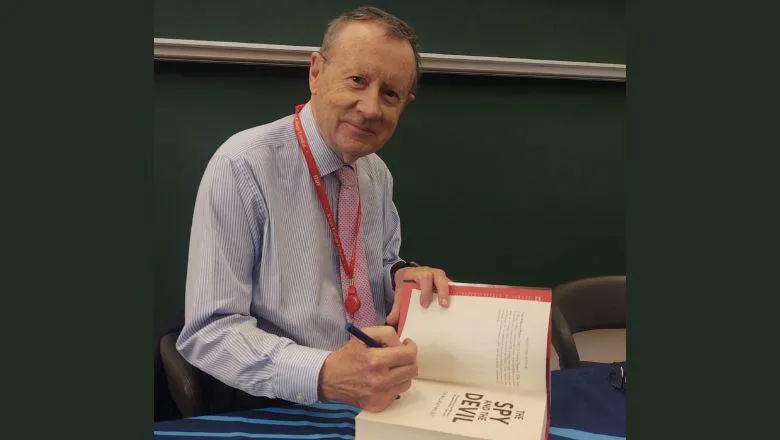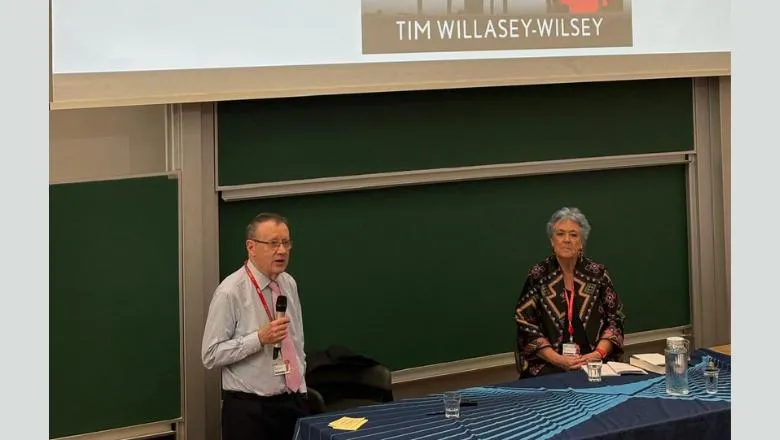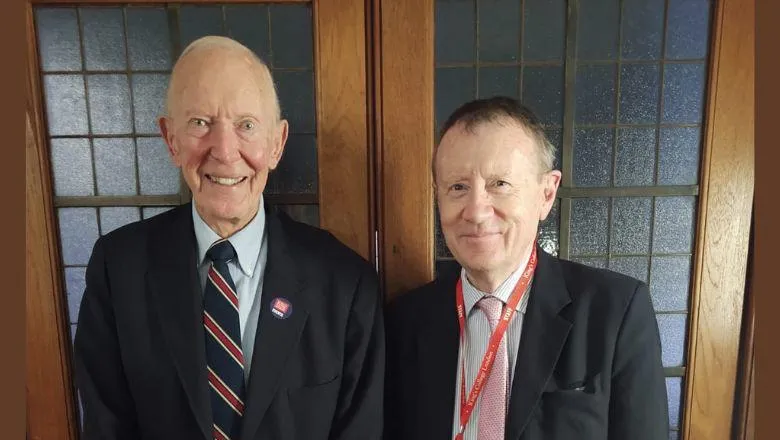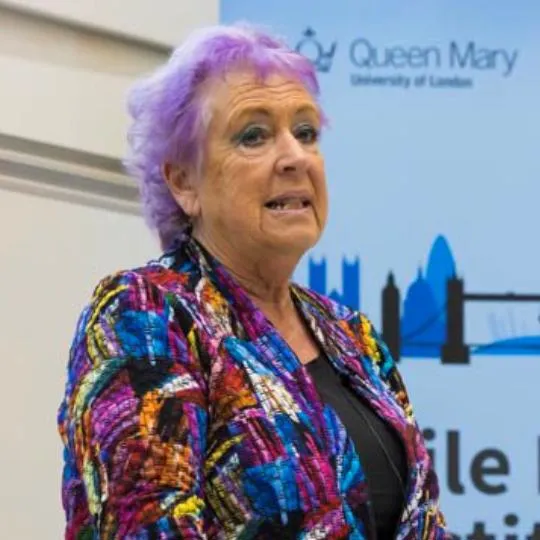There’s no doubt with Putin moving inexorably westwards Bill de Ropp would have been a very, very worried man.”
Tim Willasey-Wilsey, Visiting Professor of War Studies
15 May 2025
The Spy and the Devil: Visiting Professor of War Studies tells the remarkable story of the MI6 agent who spied on Hitler
The covert activities of an MI6 secret agent who monitored Adolf Hitler and his inner circle between the World Wars was the subject of an engaging book launch on Tuesday. Tim Willasey-Wilsey, a Visting Professor in the Department of War Studies, introduced his new book 'The Spy and the Devil' to an appreciative audience on the Strand campus. He recounted the 30-month research adventure during which he gradually pieced together the extraordinary life of Bill de Ropp – a Lithuanian Baron turned-Brit who worked for the Secret Intelligence Service in the 1930s.

The book launch, which was organised by King’s Centre for the Study of Intelligence, included a conversation with Gill Bennett, Visiting Research Fellow in War Studies, former Chief Historian of the Foreign & Commonwealth Office and a specialist in the history of secret intelligence.
The emerging spy
'The Spy and the Devil' traces the life of Bill de Ropp beginning with his origins in Lithuania as a German Balt before settling with a British wife in Wiltshire, after completing his Master’s degree in Engineering at the University of Birmingham. De Ropp came from aristocracy, spoke four languages and demonstrated the ability to move in a wide variety of circles – Professor Wilsey argues that this triple threat of linguistic skill, lineage and likeability is what made him so well suited to the role of a “grey man” in espionage.
But, as Wilsey discovered, spying was not de Ropp’s initial career choice. He was first recruited as a Balloon Officer during the First World War as part of the Royal Flying Corp. Moored in a basket 5,000 feet above the Western front directing British artillery, this was a high-risk role but one he survived unscathed.
After the war, de Ropp volunteered to work for Stewart Menzies, who was head of the military division of the Secret Intelligence Service (SIS) – MI6 as we now know it. This ended up bringing him full circle back to the Baltic States, where he was immediately deployed largely due to his familiarity with the languages, and where his surveillance and reporting career began.

Professor Wilsey’s talk explored de Ropp’s methods of reporting to an intelligence service that had become noticeably depleted after the First World War, due to a perceived lack of need during peacetime. He gave examples of what information de Ropp provided to SIS and – most poignantly – how it was received by Britain of the 1930s, which was understandably averse to the potential of conflict on any scale resembling that which had so deeply scarred it only 20 years prior. Based in Berlin masquerading as a reporter for The Times, de Ropp fed back to an unreceptive Whitehall that the German Luftwaffe was being regrown clandestinely in Russia. When he reported on a boisterous political party emerging out of Munich, there was initially little interest. Even in 1941, after the outbreak of war, he submitted a report that Operation Barbarossa (the German invasion of the Soviet Union) looked like it was failing, which was only accepted by London as the truth a month later.
But despite evidence of such challenges, Professor Wilsey credits Bill de Ropp with turning the SIS “from a provider of small-level tittle-tattle into a geopolitical service.” He evidences this particularly from de Ropp’s report 'What Should We Do?' which ultimately informed Lord Halifax and Neville Chamberlain’s approach to the Munich Agreement in 1938. Wilsey also shared unique examples of de Ropp’s high-level espionage successes, including a visit to a German Messerschmitt factory with Bristol Aeroplane Company’s chief engineer Roy Fedden, where the two were able to analyse the Spitfire’s main design rival under the guise of improving Germany’s image to the Allies.
Source material from across the world
In tracing the de Ropp name, Professor Wilsey’s search for evidence and sources took him to various locations in multiple countries. He told the audience about the “historian’s dream” cache of source material that had been assembled for him in the guest room of Bill de Ropp’s grandson, James de Ropp, when he visited him in Knoxville, Tennessee, to begin the research quest in earnest. In a surprise move for the audience, Wilsey then introduced James de Ropp himself to them. James spoke of his pride not only in his grandfather's work as an agent but also in Professor Wilsey for giving it a platform through 'The Spy and the Devil'.
Wilsey’s visits also included Lithuania and Germany where he met surviving members of the family von de Ropp (Bill’s original German name) and studied memoirs and photographs that shed light on just some of the horrors of the Nazi occupation.

Bill de Ropp’s work and its relevance today
It is a lack of record of Bill de Ropp that Professor Wilsey cites as testament to his success as a spy. He noted that while the SIS was for a while under massive surveillance by the Swiss from 1939 to 1942, de Ropp’s name does not appear in their archives, evidencing his ability to evade that suspicion. And while these events happened almost a century ago, Professor Wilsey drew sobering resonances with modern day evolving security issues, stating, “There’s no doubt with Putin moving inexorably westwards Bill de Ropp would have been a very, very worried man.”
The Spy and the Devil is available to buy from Waterstones and Amazon.
About the speakers
Tim Willasey-Wilsey CMG is Visiting Professor of War Studies at King's College, London and a former British diplomat who served in Africa, Latin American, Asia and Europe. Tim writes for a number of newspapers, academic journals, websites and think tanks. He is a Senior Associate Fellow at Royal United Services Institute (RUSI) and regularly appears on Times Radio podcasts.
Gill Bennett is a Visiting Research Fellow in the Department of War Studies. Gill was Chief Historian of the Foreign & Commonwealth Office from 1995 to 2005 and Senior Editor of the FCO’s official history of British foreign policy, Documents on British Policy Overseas. As an official historian in Whitehall for over forty years, she provided historical advice to twelve Foreign Secretaries under six Prime Ministers, from Edward Heath to Tony Blair. A specialist in the history of secret intelligence, she has worked in the Cabinet Office and was part of the research team working on the official history of the Secret Intelligence Service by the late Professor Keith Jeffery, published in 2010. She is a Senior Associate Fellow of the Royal United Services Institute and a Fellow of the Royal Historical Society.
You can find more events from KCSI here and from the School of Security Studies here.

